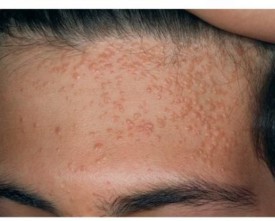
Flat Warts on the Face and Forehead
Juvenile warts are more commonly known as flat warts, and get their name from the fact that they are more likely to affect children and young people and adults. That is because as we age, our immune system develops resistance against the HPV virus, which is what causes them.
How to identify a juvenile wart
A juvenile wart can be identified by its tiny size which is about the size of a pinhead but can sometimes be larger up to the size of a small pencil erasure. Their colorization is usually the same as skin, somewhat pinkish white, so juvenile warts are not easily noticeable unless you are looking for them.
You will rarely see one juvenile wart alone as they normally appear in clusters and often in a linear structure. The top of a flat wart is, as the name would suggest, flat and it is also smooth to the touch rather than coarse as are most warts. They are most commonly located on the face, arms, and legs, but may appear in other areas as well.
What causes the development of juvenile warts?
They are caused by an infection by a common virus called HPV which gains access to the skin through a cut or abrasion. The warts will often develop along a scratch line, or on skin areas that are shaved frequently such as men’s faces and women’s legs. A razor that is infected with the virus can easily transmit it when the skin is nicked during shaving.
The HPV virus is highly contagious and can be transmitted through human contact as well as physical contact with an environment that is conducive to the virus. The virus thrives in warm and wet environments such as wet bathrooms, and pool or beach areas.
If you have an open cut on your skin it is recommended that you cover it with a bandage to prevent the virus from infecting you if you are going to be spending time in one of these locations. Shoes or sandals should be worn at the pool and the beach rather than going barefoot. It is also a good idea to do the same at the gym or other public places.
How to get rid of flat warts
Treatment of these tiny warts is tricky because of their small size and the fact that they are usually so bountiful in number. The autoimmune system will fight back against infection and often the warts will disappear on their own in a matter of a month or two.
There are also medications which may be obtained without a prescription which are helpful for their removal. Solutions containing salicylic acid can usually get rid of them in short order. If the warts are stubborn, professional assistance may be obtained from your doctor.
Your dermatologist may use liquid nitrogen to burn the warts off of your skin, but this is rarely necessary because juvenile warts are not as robust as other types and often disappear on their own without medical intervention.
Recommended medications for the removal of juvenile warts
OTC Medicine for Wart Removal
 |  |  |  |
| Wart Remover Pads/Adhesives | Liquid Wart Remover | Wart Freeze Off | Wart Removal Pen |


Leave a Reply